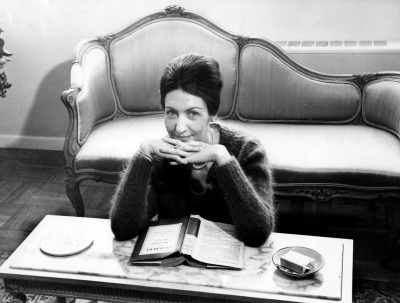Commentary
I first discovered Australian literature in Argentina. While I was there studying Argentinian literature at the University of Buenos Aires in 2009–10, I spent many nights hunched over the table in our dingy kitchen with one of my housemates, Teresa. We would pick over the politically infused vernacular of the short stories ...
... (read more)We are on the verge of another revolution in dictionary-making. Since the seventeenth century there have been three major revolutions in lexicographic practice. In 1604 Robert Cawdrey produced the first monolingual English dictionary, which was – radically – arranged alphabetically. In the middle of the eighteenth century, Samuel Johnson employed literary citations to illustrate the meaning of the words in his dictionary. And in the nineteenth century, James Murray began to produce the first great historical dictionary, tracking the use of a word over time, and extended the making of dictionaries beyond his Scriptorium of lexicographers working in Oxford by calling on contributions from around the globe. This was an enormous undertaking, and the first edition of the Oxford English Dictionary (OED), begun in 1859, was not completed until 1928 (the second edition followed in 1989, and the third edition, published quarterly online, was begun in 2000).
... (read more)My husband is proud to claim that in the 1950s, when they were both employed at Covent Garden, he was paid a larger salary than Joan Sutherland was. Fresh from Sydney, she had joined the company in 1952, and was soon appearing in small roles, including Clotilde, opposite Maria Callas’s Norma. This was followed by several years of steady progress and major roles (Agathe, Antonia, Micaela), but no great public success. My husband watched Joan’s progress from the beginning of her time and realised, as did others, that here was a great singer in the making. Then, in February 1959, Sutherland, directed by Franco Zeffirelli, made her triumphant début as Lucia di Lammermoor, and everything changed dramatically, including her fees.
... (read more)Twenty years ago, when I was at the Wadsworth Atheneum in Hartford, I heard of an Arthur Boyd exhibition in SoHo. Recklessly, without seeing the show, I urged my American friends to see one of Australia’s foremost contemporary painters. The gallery, unknown to me, turned out to be small and unimpressive. There were five or six late paintings, including one of those large, multi-figured bathers, with that disconcerting quality of Boyd at the end of his career, both slapdash and commercial at the same moment. ‘So this is what contemporary Australian painting looks like?’ my companion asked ironically, just within the bounds of good manners.
... (read more)'Alpha and Omega' Nathan Hollier on the establishment of Monash University Publishing
On 8 September 2010, in the foyer of the Robert Blackwood Hall at Monash University, beneath the beautiful ‘Alpha and Omega’ stained-glass window created by Leonard French and connoting humankind’s endless striving for achievement, Monash University ePress became Monash University Publishing. It was very appropriate that the press should be launched by B ...
I visited Randolph Stow on impulse. We had corresponded briefly and since I was passing through London in February 1975, I asked if I might meet him. He kindly invited me to spend the day with him in East Bergholt, a village in Suffolk, two hours from London. Stow had been living there, in Dairy Farm Cottage, for some six years. Six years later, he moved to nearby Harwich.
... (read more)As with so many of the events that mark Israel’s history, the deadly attack on the Gaza flotilla in late May seemed frustratingly – and tragically – to encapsulate many of the arguments, insecurities, defences, and emotions that swirl around the enduring conflict in the Middle East.
... (read more)Why on earth should Australian filmmakers want to try replicating Hollywood? No one can do Hollywood as well as Hollywood can, and the attempts to emulate it have usually, perhaps inevitably, led to flavourless or otherwise misbegotten enterprises. I know that this is the era of international co-productions, and that where the money comes from is undoubtedly influential, but where the creative personnel come from is surely still more so. I want to argue for the cultural significance of the small-scale filmmaking that doesn’t depend on US funding and thereby isn’t subject to the sorts of compromise that such involvement may entail.
... (read more)Biography seems relatively easy to produce, but difficult to write well. It is therefore treated with a certain amount of suspicion by academics. Historians tend to regard it as chatty, not primarily concerned with policy or the identification of social factors; literary people are more sympathetic, but, in order to blot out the prosy or the fact-laden, tend to revert to a default position. Biography for them is basically about writers, and best written by literary academics.
... (read more)In October 2009, Shirley Hazzard spoke at the New York launch of the Macquarie PEN Anthology of Australian Literature. Hazzard read from People in Glass Houses, her early collection of satirical stories about the UN bureaucracy. Her appearance serves to remind Australian readers that Hazzard continues to occupy a defining, if somewhat attenuated, place within the expansive field of what Nicholas Jose described in 2008, on taking up the annual Harvard Chair of Australian Studies, as ‘writing that engage[s] us with the international arena from the Australian perspective’. Jose went on to cite Hazzard’s most recent novel, The Great Fire (2003), as part of ‘a range of material which Americans would not necessarily think of as Australian’.
... (read more)

